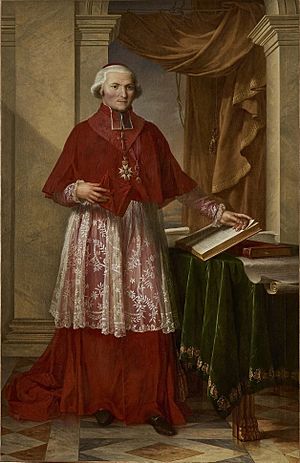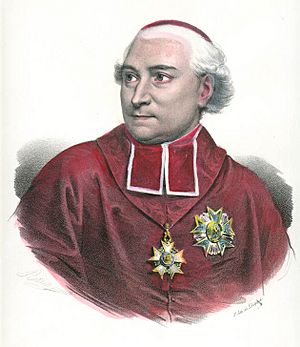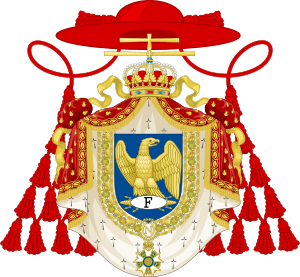Joseph Fesch facts for kids
Quick facts for kids His EminenceHis Most Eminent Highness His Serene Highness Joseph Fesch |
|
|---|---|
| Cardinal, Archbishop of Lyon Sovereign Prince Prince of France Peer of France Roman Prince |
|

Cardinal Fesch by Charles Meynier, 1806
|
|
| See | Lyon |
| Enthroned | 15 August 1802 |
| Reign ended | 13 May 1839 |
| Other posts | Cardinal-Priest of Santa Maria della Vittoria (1803–1822); in commendam (1822–1839) Cardinal-Priest of San Lorenzo in Lucina Grand Almoner of France (1805 - 1814) |
| Orders | |
| Ordination | 1787 |
| Consecration | 15 August 1802 by Giovanni Battista Caprara |
| Created Cardinal | 17 January 1803 |
| Rank | Cardinal-Priest |
| Personal details | |
| Born | 3 January 1763 Ajaccio, Republic of Genoa |
| Died | 13 May 1839 (aged 76) Rome, Papal States |
| Nationality | French |
| Denomination | Roman Catholic |
| Coat of arms | |
Joseph Fesch (born January 3, 1763 – died May 13, 1839) was a French priest and important diplomat. He was the uncle of Napoleon Bonaparte, who was the famous French Emperor. Joseph Fesch became a very important church leader. He was the Archbishop of Lyon and a Cardinal.
Fesch was also a famous art collector. He gathered one of the largest art collections of his time. He used many of these artworks to create the Musée Fesch in Ajaccio. This museum still holds many important art pieces linked to Napoleon.
Joseph Fesch was born in Corsica. His father was Franz Faesch from Switzerland, and his mother was Angela Maria Pietrasanta. His family was well-known in Basel. Joseph Fesch became very important in France after Napoleon took power in 1799.
He quickly gained many titles:
- Archbishop of Lyon in 1802
- Cardinal in 1803
- Ambassador to the Holy See (the Pope's government) in 1804
- A French senator and count in 1805
- Grand Almoner of France (a high church official) in 1805
- A sovereign prince in 1806
- Prince of France in 1807 (a very special title shared only with Napoleon's closest family)
- Peer of France in 1815
- A Prince of the Papal States (lands ruled by the Pope)
As a member of the Imperial House, he was even in line to become emperor if something happened to Napoleon's direct family.
Joseph Fesch was Napoleon's main diplomat when dealing with Pope Pius VII. However, their relationship became difficult as Napoleon's relationship with the Pope worsened. Even so, Napoleon stayed loyal to his uncle. Fesch performed important ceremonies for Napoleon. He married Napoleon to Joséphine de Beauharnais in 1804. In 1810, he married Napoleon to Marie Louise of Austria. In 1811, he baptized Napoleon's son, Napoleon II.
After Napoleon's empire ended in 1815, Fesch was sent away from France. He moved to Rome with his half-sister Laetitia, Napoleon's mother. He lived in the Palazzo Falconieri, focusing on art and helping others.
Contents
Early Life and Career
Joseph Fesch was born in Ajaccio, a city on the island of Corsica. His father was a Swiss officer. His mother had a daughter from a previous marriage, Letizia Ramolino, who later became Napoleon's mother. This made Joseph Fesch Napoleon's half-uncle.
In 1781, Joseph Fesch began studying to become a priest. He was ordained as a priest in 1785. At 24 years old, he became an important church official in Ajaccio. After his mentor died in 1791, Fesch became the protector of his sister's family, including young Napoleon.
When the French Revolution started in 1789, Fesch did not agree with many of the new government's actions. He especially protested a law called the Civil Constitution of the Clergy. This law changed how the church worked in France. Because of these changes, he had to leave his church duties for a while.
Rise to Power with Napoleon
Joseph Fesch joined the Bonaparte family in their struggles. He supported the French cause against local Corsican leaders. This led him to leave Corsica with Napoleon's mother and move to Toulon in 1793.
During this time, it was hard to find church work. So, Fesch took on different jobs in civil life. When Napoleon Bonaparte became the commander of the French army in Italy, Fesch became a supply officer for that army. His career quickly improved when Napoleon became the leader of France in 1799.
When Napoleon decided to bring back the Roman Catholic religion to France, Fesch returned to his church work. He played a big part in the talks that led to the Concordat of 1801. This was an agreement between France and the Pope. As a reward, Fesch became the Archbishop of Lyon in 1802. Six months later, he became a Cardinal.
Diplomat and Conflict
In 1803, Napoleon appointed Fesch as the French ambassador to Rome. Fesch had the difficult job of convincing Pope Pius VII to come to Napoleon's coronation as Emperor in Paris in 1804. Fesch successfully persuaded the Pope. For this, he received high honors, including a special award called the grand cordon of the Legion d'Honneur. He also became a grand-almoner of the empire and a member of the French senate.
However, Napoleon and the Pope started to disagree strongly on political and religious matters. Fesch tried to help them make peace, but it was difficult. Napoleon was very demanding, and the Pope refused to give in on important church issues. Napoleon sometimes criticized Fesch for being too weak. Fesch tried his best to get the church to cooperate with the government. For a time, he and the Pope were not speaking, and Napoleon called him back from Rome.
The situation got worse in 1809 when Napoleon took over the Papal States, which were lands ruled by the Pope. Napoleon offered Fesch the important position of archbishopric of Paris, but Fesch turned it down. He did agree to join a church committee set up by the emperor, but this committee was later closed.
Later Years and Legacy
In 1811, Napoleon called a meeting of French church leaders. Fesch was chosen to lead this meeting. But again, he failed to please the emperor and was sent back to his own diocese. The disagreements between Fesch and Napoleon grew even more in 1812.
In June 1812, Pope Pius VII was moved to Fontainebleau and kept under watch. Napoleon hoped the Pope would agree to certain things about the Concordat. Fesch wrote a letter to the Pope, which Napoleon saw. Napoleon was so angry that he stopped Fesch's payment.
As Napoleon's empire faced problems in 1812-1813, he treated the Pope more kindly. This made Fesch's position easier for a while. However, when Napoleon gave up his throne in 1814, Fesch moved to Rome. He was welcomed there.
When Napoleon briefly returned to power in 1815, Fesch went back to France. He resumed his duties as Archbishop of Lyon and became a member of the senate. But after Napoleon's final defeat in 1815, Fesch returned to Rome with his older sister, Letizia. He lived the rest of his life there, surrounded by his many art treasures. He gave many of these artworks to the cities of Lyon and Ajaccio. He passed away in Rome in 1839.
Coat of Arms
As a member of Napoleon's imperial family, Joseph Fesch was given a new coat of arms. This new design was based on the imperial coat of arms of France. His family, the Faesch family, had traditionally used a different coat of arms.
Joseph Fesch's Art Collection
Joseph Fesch's art collection was huge, with almost 16,000 paintings at one point. Most of his collection included Italian artworks from the Renaissance up to the 18th century. He also owned paintings from the Dutch Golden Age and French artworks of his time. He also collected classical sculptures.
Fesch was one of the first collectors to appreciate "Italian Primitives," which are paintings from the 1400s. The Musée Fesch in Ajaccio now holds a large part of his collection. This includes works by famous artists like Botticelli, Giovanni Bellini, and Titian. Another important part of his collection was sold at an auction in 1845.
Some famous paintings that were once owned by Fesch, and are now in other museums, include:
- The Entombment by Michelangelo, now in the National Gallery, London
- Saint Jerome in the Wilderness by Leonardo da Vinci, now in the Vatican Museums
- Adoration of the Shepherds by Giorgione, now in the NGA, Washington
- Mond Crucifixion by Raphael, now in the National Gallery, London
- Adoration of the Magi by Bramantino, now in the National Gallery, London
- Last Judgement by Fra Angelico, now in the Gemäldegalerie, Berlin
- The Broken Mirror by Greuze, now in the Wallace Collection, London
Honors and Awards
Joseph Fesch received several important honors during his life:
- Great Eagle (Grand Cross) of the Legion of Honour
- Knight of the Order of the Golden Spur (1802)
- Knight of the Order of the Golden Fleece (1805)
See also
 In Spanish: Joseph Fesch para niños
In Spanish: Joseph Fesch para niños
- François Carlo Antommarchi
- Napoleon and the Catholic Church



